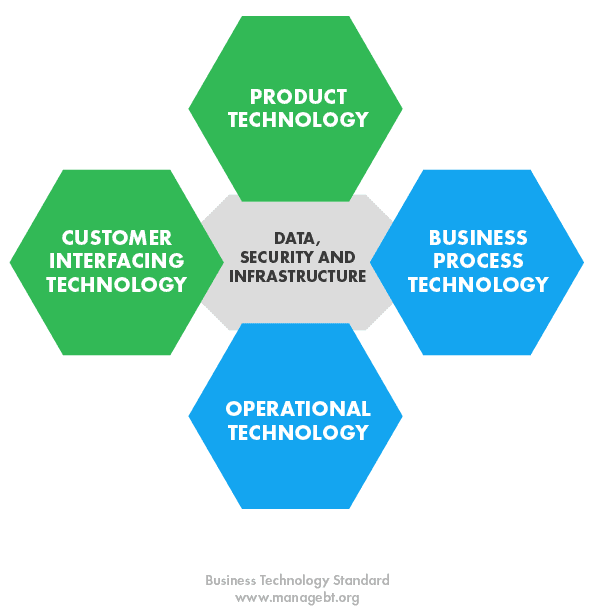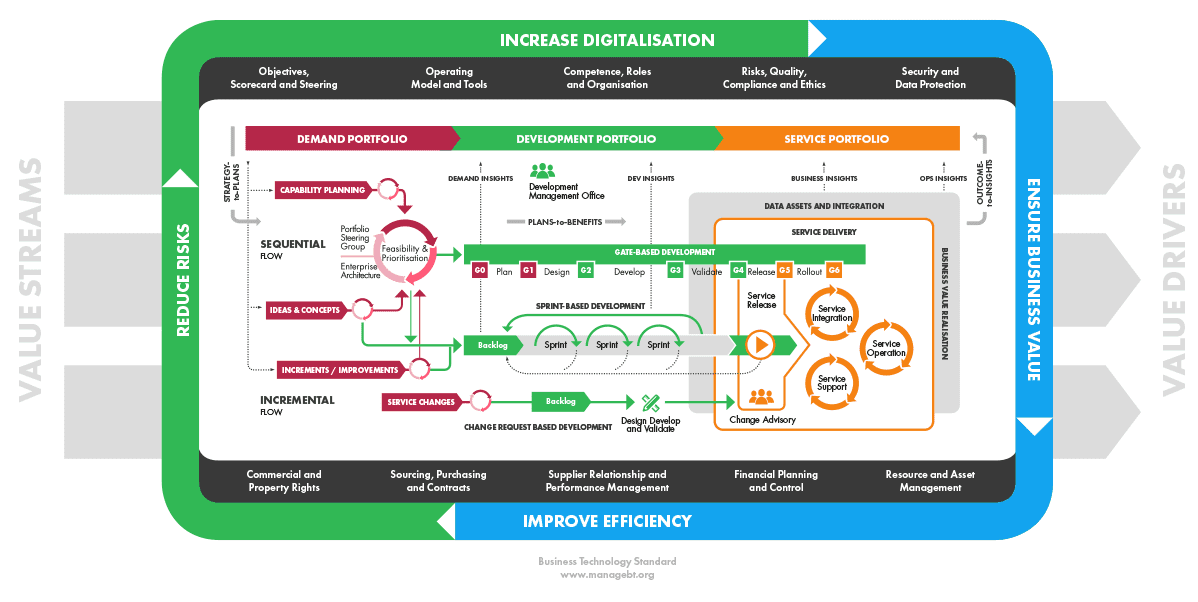Businesses, regardless of sector, are living, breathing, and operating in an environment where information technology is changing the landscape around them, transitioning from the back room of an organisation into the hands of customers, employees, and society. There is a continual shift towards a service economy, with services ever more tailored and personalised for the customer.
As technology has advanced over the last 10 years, a number of phenomena have emerged that, when combined, have rapidly and radically transformed the ability of businesses to construct customer services and products. Most importantly, the speed at which innovation and incremental improvement can occur has also increased. If you prefer to read an e-book, please download it here.
Business technology is a strategy for organising and coordinating technology management across the entire enterprise. It is a set of management practices, tools, organisational structures, and technology governance designed to ensure that the use of technology is optimised across the enterprise with the overarching aim of satisfying customer needs and expectations. Most businesses understand that they need to challenge not only their competitors but also themselves in order to constantly improve their customers’ view and their ability to meet market demand.
When information technology was introduced to businesses over 30 years ago, it was such a specialised topic that organisations created new departments with the remit and responsibility for managing it. This resulted in the birth of the IT department, which was seen by many as a pure support function and separate from the business.
Large amounts of effort have been spent since in trying to “contain” information technology, ensure that it is under the watchful eye of IT teams and that spend is controlled. Of course, cost control is still a major required discipline, however, digital has unleashed technology and made it widely available, meaning it can no longer be efficiently controlled by a single department.
Today’s technology function should work alongside all business areas to make their skills available, whilst embracing those disciplines of customer focus, revenue generation, and product development from other parts of the organisation. This is not a one-way conversation – marketing teams, for example, need to embrace the technology management skills available to them to prevent runaway costs or implementation of solutions that cannot interact with others across the internal ecosystem.
Many organisations have found themselves in limbo – somewhere between the digital revolution and the status quo. They lack the capability to integrate incremental improvement with disruptive digital innovation. To frame the challenge, business technology introduces three core elements as illustrated in the picture below.
Figure 1.1.1 Business Technology mindset model with three dimensions
Emerging technologies are accelerating digital transformation, requiring business and process development and forward-looking governance. Business capabilities are the sum of all processes and assets (systems and data) within the company and comprise the entire business organisation, including any supporting functions within the organisation. Business capabilities are the key for developing the business and for utilising technology in the best possible way. Transformation comprises of the parts and processes of an organisation that are engaged in improving business capabilities. Interested in developing your skills related to business capabilities and transformations? Check our certification trainings.
Digitalisation provides new business opportunities and requires consistent design thinking on how to face customers, partners and employees in a networked multi-channel world.
The digital frontline can be defined as any digital means that connects the company to the user and is visible to the user, whether the user is a customer or a partner, or whether the customer is internal or external.
Customer experience is at the heart of all digital frontline activities. Digital frontline is a crucial area as it is the key area where the emerging business focus and growth possibilities reside and where digital transformation happens through speed and agility. Digital apps and web, as well as digital enterprises, enable the creation of new business possibilities around customer experience, digital business and internet of things (IoT) services.
Traditional information technology management function (or IT) should be the technology backbone that is responsible for development, and management of digital and administrative solutions in a professional way. The technology backbone consists of all information technology systems and processes that support the running of the businesses operations, through the management of end-user services, plus enterprise and business applications. It is where the essential business asset of a company resides, and the purpose is to provide operational efficiency to the company through reliability, security and scalability.
Technology exists within many areas of the enterprise today. Often this technology is outside of the influence of the traditional CIO and technology function. Every business is different, and the type, location and amount of technology will rightly vary within each area.
We define four distinct categories of technology: customer interfacing technology, product technology, operational technology and business process technology.
Each of the four technology areas contain a wide variety of technologies, some overlapping and some discrete. These are underpinned by infrastructure, data and security.
Figure 1.1.2 Business Technology domains
The key characteristic of this technology type is interaction with the customer and the technology centres around the customer experience. Customer interfacing technology is all about the digitalisation of customer facing processes and services. Thus, it is in this area where digital initiatives have an obvious and direct impact. Improving or implementing these technologies drives a need to review end to end customer journeys. When these solutions are developed, the business should ensure that their strategy is not constrained to digital channels only. This constraint can be acceptable as a short-term strategy. However, as previously discussed, digitalisation is a much broader topic and needs to be viewed as a broader strategy.
This area consists of information technology embedded within the products the company sells: technology that can be operated, monitored and/or interfaced remotely and can interact with its environment 24/7. Thus, only the technology component of the product that fulfils these criteria can be seen as product technology, not necessarily the whole product itself. For example, a lawn mower itself does not fulfil these criteria, but in a robot lawnmower the embedded technology enabling its remote control and operation fits the product technology definition.
Whilst customer interfacing technology provides the gateway for interaction with your customers, it is often the technology within your product, whether it be a banking product, electronic goods or professional services to name a few, that provides the real value to customers. Technology innovations within this area are fast moving with new rich sources of data and new techniques such as rapid prototyping, agile development and new business models such as the “as-a-Service” model often used.
Operational technology contains all information systems used for managing, operating and monitoring automation systems and other “shop floor” systems. Information technology is expanding into this area even more than before. Many previously low-tech or even manual operations today start with an information technology enabled check, such as the servicing of a car. What used to be a purely manual operation is now assisted by operational technology such as a laser assisted wheel alignment machine as an example.
Business Process Technology consists of information technology and solutions that are used for managing business processes and executing business transactions, i.e. systems that support day-to-day business operations. Classic examples of business process technology are the enterprise resource planning (ERP) and customer relationship management (CRM) systems used in organisations.
In today’s business world, information technology penetrates organisations from an increasing number of angles. This trend will continue to accelerate, a traditional technology department can no longer act as the only gatekeeper to an organisations’ technology.
In many organisations, the cooperation between the business and technology functions is not optimal and could enable greater business outcomes. To overcome this, business leaders must embed a culture of cooperation within the organisation so that technology management skills are fully applied as needed across all business units.
This shifting landscape demands that your business is organised in a way that allows you to maximise business potential, reacting rapidly to opportunities, and driving continuous improvement and change.
Transforming from traditional, siloed business and technology functions into business technology organisation also presents a fantastic opportunity to leverage technology management practices directly in the business teams where it can have the largest impact. Business technology will ensure that businesses are able to derive real value from technology, and ultimately, to better serve their customers.
